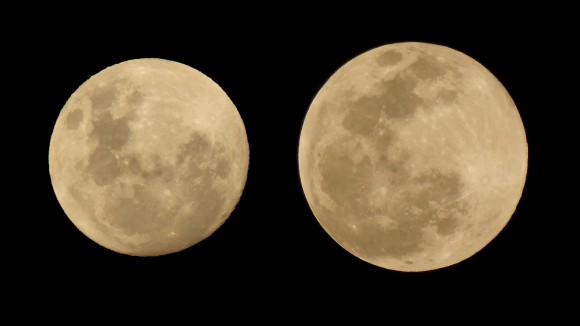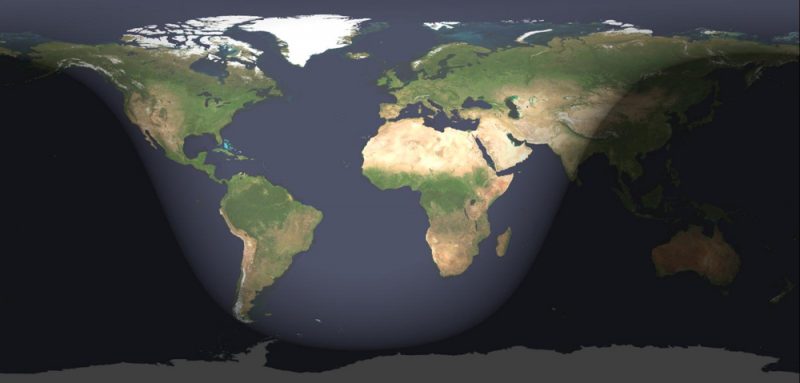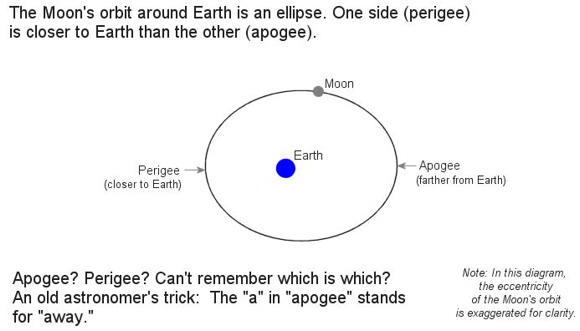Smallest Full Moon
Here’s some information about this month’s full moon from Bruce McClure on Spaceweather.com.
June 9, 2017 brings the farthest full moon – and hence the smallest full moon – of the year. We’ve heard it called the micro-moon or mini-moon. That bright starlike object near tonight’s moon isn’t a true star; it’s the planet Saturn.
This June full moon occurs less than one day after reaching lunar apogee, the moon’s farthest point in its monthly orbit. The near alignment of full moon and lunar apogee team up to give us the farthest and smallest full moon of the year.
One fortnight (or approximately two weeks) before this June 9 micro-moon, it was the closest new moon of the year on May 25, 2017. On that date, the new moon paired up quite closely with perigee, the moon’s nearest point in its monthly orbit. And thus we had the closest new moon – and closest supermoon – of 2017.
The year’s farthest full moon on June 9 lies some 30,000 miles (50,000 km) farther from Earth than did the year’s closest new moon on May 25.

View larger. | At right, the August 29, 2015 supermoon. At left, the March 5, 2015 micro-moon – smallest full moon of that year. Photos by Peter Lowenstein in Mutare, Zimbabwe.
The micro-moon or mini-moon often returns about one month and 18 days later with each passing year, meaning that, in 2018, the year’s smallest full moon will come on July 27.
In 2019, the year’s smallest full moon will fall on September 14; and in 2020, the smallest full moon will occur on October 31. The micro-moon or mini-moon frequently recurs in periods of 14 lunar months (14 returns to full moon), a period of about one year and 48 days.
The crest of the moon’s full phase on June 9, 2017 comes at precisely 13:10 Universal Time.
Although the full moon occurs at the same instant all around the world, our clocks read differently in various time zones. In the United States, the moon turns exactly full on June 9, at 9:10 a.m. EDT, 8:10 a.m. CDT, at 7:10 a.m. MDT and 6:10 a.m. PST.

Image via the US Naval Observatory. Day and night sides of Earth at the instant of the June 2017 full moon (2017 June 9 at 13:10 Universal Time). The shadow line at left depicts sunrise June 9 and the shadow line at right represents sunset June 9.
So in the Americas, the full moon happens during the daylight hours on June 9, when the sun is above our horizon and the moon is below it.
No matter where you live worldwide, look for the moon to appear plenty full on the night of June 9. As with any moon at the vicinity of full moon, it’ll light up the nighttime from early evening until dawn.
In North America, we often call the June full moon the Strawberry Moon; and more generally in the Northern Hemisphere, the June full moon goes by the appellation of Rose Moon or Honey Moon. The terms supermoon or micro-moon aren’t names from folklore (like Strawberry Moon). Those names aren’t bound to a particular month or season.
They’re just a modern terms to describe the year’s largest and smallest (or brightest and faintest) moons.
Fourmilab’s lunar perigee and apogee calculator
Every month for the next seven lunar months, the full moon will come closer and closer to Earth until the full moon finally coincides with perigee (instead of apogee) on January 2, 2018, to present the closest and largest full moon (plus the closest and largest supermoon) of 2018. Then seven lunar months after the closest and largest full moon supermoon on January 2, 2018, it’ll be the smallest full moon micro-moon all over again on July 27, 2018.
But for now, enjoy the year’s smallest full moon near the planet Saturn on June 9, 2017!!
Bottom line: The micro-moon or mini-moon – smallest full moon of 2017 – comes on June 9. It lies about 30,000 miles (50,000 km) farther away from Earth than does the new moon supermoon of May 25, 2017.


Leave a Reply
You must be logged in to post a comment.